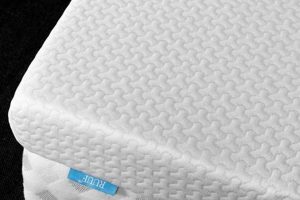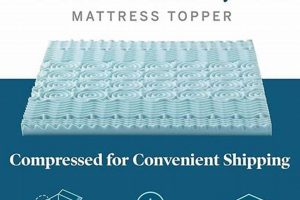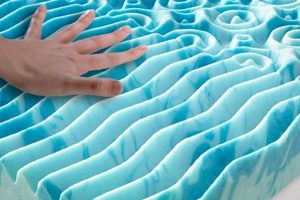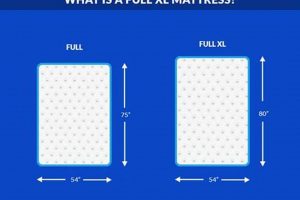A textile layer designed to be placed atop a twin extra-long bed is intended to enhance comfort and protect the underlying mattress. This product typically adds a layer of cushioning and may possess features such as waterproofing or temperature regulation. It represents an additional element between the sleeper and the mattress, influencing the overall sleep experience.
The addition of this bedding accessory can be significant for various reasons. It provides an easily removable and washable surface, safeguarding the mattress from spills and stains, thereby prolonging its lifespan. Furthermore, it can contribute to improved sleep quality by increasing the softness or firmness of the sleeping surface. Historically, similar solutions were implemented to protect mattresses from wear and tear, evolving over time with advancements in materials and manufacturing.
This detailed overview serves as an introduction to the aspects of choosing, utilizing, and maintaining an appropriate sleep surface enhancement. The following sections will delve into specific features, materials, and considerations for selecting the ideal product to optimize sleep comfort and mattress protection.
Selecting and Maintaining a Twin XL Bed Mattress Pad
The subsequent guidelines are designed to assist in the effective selection and upkeep of a suitable sleep surface enhancement for a twin extra-long bed, promoting longevity and hygiene.
Tip 1: Prioritize Material Composition: Evaluate the fiber content, considering factors such as breathability, hypoallergenic properties, and ease of care. Cotton, memory foam, and synthetic blends each offer distinct characteristics affecting comfort and maintenance.
Tip 2: Assess Depth Compatibility: Confirm the dimensions accommodate the mattress’s thickness, ensuring a secure and taut fit. Insufficient depth can result in slippage and diminished performance.
Tip 3: Examine Waterproofing Features: Determine if liquid resistance is a necessity based on the sleeping environment. Waterproofing can protect against spills but may affect breathability.
Tip 4: Evaluate Temperature Regulation: Consider thermal properties based on climate and individual preferences. Cooling technologies or breathable fabrics can mitigate overheating.
Tip 5: Implement Regular Cleaning Protocols: Adhere to manufacturer instructions regarding laundering frequency and drying methods. Consistent cleaning prevents the accumulation of allergens and maintains hygiene.
Tip 6: Inspect for Wear and Tear: Periodically assess the structural integrity, paying attention to seams, elastic bands, and surface pilling. Early detection of damage can prevent further degradation.
Tip 7: Address Stains Promptly: In the event of spills, treat the affected area immediately using appropriate stain removal techniques. Delayed action can lead to permanent blemishes.
These strategies enhance the functionality and lifespan of a bed surface layer, promoting both comfort and the preservation of the underlying mattress.
The ensuing sections will delve into advanced considerations regarding product care and optimization of the sleep environment.
1. Dimensions
The dimensional specifications of a twin XL bed mattress pad are paramount to its proper function and efficacy. A mismatch between the pad’s dimensions and the target mattress results in diminished protection and impaired comfort. Specifically, a pad that is too small leaves portions of the mattress vulnerable to spills, stains, and wear. Conversely, a pad that is too large may bunch, shift, and create an uneven sleeping surface. In both instances, the intended benefits of mattress protection and enhanced sleep quality are compromised.
A real-world example illustrates this point: a college dormitory often uses twin XL beds. If a student purchases a mattress pad intended for a standard twin bed, which is shorter in length, a significant portion of the mattress at the foot of the bed remains exposed. This unprotected area is susceptible to damage, particularly given the higher turnover and potentially less careful use associated with dormitory settings. The consequence is premature mattress degradation and reduced hygiene, ultimately necessitating earlier replacement.
In summary, adherence to the correct dimensional specifications is not merely a detail but a fundamental requirement for a mattress pad to perform its intended purpose. Overlooking this aspect can lead to compromised mattress protection, reduced sleep comfort, and ultimately, a less cost-effective investment. Precise measurement and careful selection are therefore critical to realizing the full potential of a twin XL bed mattress pad.
2. Material Composition
The material composition of a twin XL bed mattress pad exerts a significant influence on its performance characteristics, encompassing comfort, durability, breathability, and maintenance requirements. The selection of constituent materials dictates the pad’s ability to protect the underlying mattress and enhance the sleeper’s experience.
- Fiber Type and Breathability
The type of fiber utilizedbe it cotton, polyester, wool, or a blenddirectly affects airflow and moisture management. For instance, cotton fibers exhibit inherent breathability, facilitating air circulation and reducing heat retention. Conversely, some synthetic fibers, while durable, may possess lower breathability, potentially leading to increased perspiration and discomfort during sleep. The material’s capacity to dissipate heat directly impacts sleep quality.
- Fill Material and Cushioning
The fill material, such as down alternative, memory foam, or polyester batting, determines the level of cushioning and support provided. Memory foam, known for its viscoelastic properties, conforms to the body’s contours, alleviating pressure points. Down alternative fills mimic the softness of natural down, providing insulation and comfort. The choice of fill material depends on individual preferences for firmness and pressure relief.
- Waterproof Membrane Characteristics
If the mattress pad incorporates a waterproof membrane, its composition and construction influence its effectiveness and breathability. Polyurethane laminates are commonly employed for their impermeability to liquids. However, the application method and thickness of the laminate affect its ability to allow air and moisture vapor to pass through, impacting comfort. A balance between waterproof protection and breathability is crucial.
- Allergen Resistance Properties
The inherent or applied allergen resistance of the materials is pertinent for individuals with sensitivities. Tightly woven fabrics and hypoallergenic fills can minimize the accumulation of dust mites and other allergens. Antimicrobial treatments may further inhibit the growth of bacteria and mold. Choosing materials with these properties is essential for maintaining a hygienic sleep environment.
These compositional factors are intertwined and collectively determine the suitability of a twin XL bed mattress pad for a given user. Material characteristics should be carefully considered in relation to individual needs and environmental conditions to optimize sleep comfort and mattress protection. Variations in material blends and manufacturing processes further expand the range of available options, necessitating informed selection based on specific requirements.
3. Waterproof Barrier
The integration of a waterproof barrier into a twin XL bed mattress pad serves as a critical protective measure, safeguarding the underlying mattress from liquid damage. This feature is particularly relevant in environments prone to spills, accidents, or excessive moisture exposure, contributing significantly to mattress longevity and hygiene.
- Material Composition and Effectiveness
The efficacy of a waterproof barrier is directly linked to its material composition. Polyurethane laminates and thermoplastic polyurethane (TPU) are commonly employed due to their impermeability to liquids. The selection of material influences the degree of protection offered. For instance, thicker laminates typically provide greater resistance to fluid penetration. The long-term durability of the material also determines its sustained effectiveness, influencing the lifespan of the barrier.
- Breathability Considerations
A critical trade-off exists between waterproofing and breathability. Impermeable barriers, while effective at blocking liquids, can restrict airflow, potentially leading to heat buildup and discomfort during sleep. Some advanced waterproof barriers incorporate microporous membranes designed to allow moisture vapor to escape while preventing liquid ingress. These technologies attempt to balance protection with comfort, addressing the limitations of purely impermeable materials.
- Hygiene and Allergen Control
The presence of a waterproof barrier contributes to improved hygiene by preventing the absorption of bodily fluids, sweat, and allergens into the mattress. This minimizes the potential for mold, mildew, and dust mite proliferation within the mattress core. The barrier also facilitates easier cleaning of the mattress pad itself, as surface spills can be readily wiped away without penetrating the underlying layers.
- Impact on Mattress Lifespan
By preventing liquid damage and the accumulation of moisture, a waterproof barrier significantly extends the lifespan of a twin XL mattress. Stains and moisture can degrade mattress materials over time, leading to structural weakening and reduced support. The barrier acts as a protective shield, minimizing these detrimental effects and preserving the integrity of the mattress for a longer period.
The incorporation of a waterproof barrier into a twin XL bed mattress pad represents a practical investment, particularly in environments where liquid spills or moisture exposure are likely. The material characteristics, breathability considerations, hygiene benefits, and impact on mattress lifespan collectively underscore the importance of this feature in maintaining a clean, comfortable, and durable sleep environment. The selection of a mattress pad with an appropriate waterproof barrier should be guided by a careful assessment of these factors.
4. Temperature regulation
Temperature regulation within the microclimate of a sleep environment directly impacts comfort and sleep quality. A twin XL bed mattress pad can be instrumental in managing heat and moisture, contributing to a more stable and conducive sleep environment.
- Material Breathability and Airflow
The composition of the mattress pad dictates its capacity to facilitate airflow and wick away moisture. Materials such as cotton, bamboo, and certain synthetic blends are inherently more breathable than others. Improved airflow prevents heat buildup, reducing the likelihood of night sweats and discomfort. Conversely, less breathable materials can trap heat, leading to elevated skin temperature and disrupted sleep. For example, a mattress pad constructed with a densely woven synthetic fabric may impede air circulation compared to one made of open-weave cotton.
- Cooling Technologies and Phase Change Materials
Advanced mattress pads may incorporate cooling technologies, such as phase change materials (PCMs), to actively regulate temperature. PCMs absorb and release heat as they transition between solid and liquid states, creating a cooling effect. These materials can buffer temperature fluctuations, maintaining a more consistent sleeping surface. An instance of this technology is a mattress pad infused with gel beads containing PCMs, which actively draw heat away from the body during periods of elevated temperature.
- Moisture Management and Wicking Properties
The ability of a mattress pad to manage moisture is critical for temperature regulation. Perspiration during sleep can lead to dampness and discomfort, particularly in warmer climates. Mattress pads with wicking properties draw moisture away from the skin, promoting evaporation and reducing humidity within the sleep environment. Polyester microfibers, for example, excel at wicking moisture, keeping the sleeper dry and comfortable. The result is a reduced likelihood of overheating and improved sleep continuity.
- Insulation and Thermal Resistance
In colder environments, a mattress pad can provide an additional layer of insulation, increasing thermal resistance and preventing heat loss. Materials such as wool and down alternatives offer excellent insulating properties, trapping warm air and maintaining a comfortable sleeping temperature. A mattress pad with a high thermal resistance value reduces the transfer of heat away from the body, minimizing the need for excessive bedding and promoting consistent warmth throughout the night.
The integration of temperature-regulating features into a twin XL bed mattress pad represents a targeted approach to optimizing sleep comfort. By carefully selecting materials and technologies that promote breathability, moisture management, and insulation, it is possible to mitigate temperature fluctuations and create a more stable and restful sleep environment. Consideration of these factors is particularly relevant for individuals who experience temperature sensitivities or who reside in climates with extreme temperature variations.
5. Secure fit
A secure fit is a fundamental attribute of a twin XL bed mattress pad, directly influencing its functionality and the overall sleep experience. The connection is causal: an improperly fitting mattress pad, irrespective of its material composition or intended features, compromises its ability to provide consistent mattress protection and comfort. Slippage, bunching, and uneven distribution of cushioning are direct consequences of a poor fit, negating the intended benefits. A real-world example involves a restless sleeper whose movements cause an ill-fitting pad to bunch up during the night, creating uncomfortable pressure points and disrupting sleep.
The practical significance of a secure fit extends beyond mere comfort. A mattress pad that shifts exposes the underlying mattress to potential damage from spills, stains, and wear. This is particularly relevant in healthcare or dormitory settings where hygiene and mattress longevity are paramount. Furthermore, a secure fit ensures that any specialized features of the pad, such as cooling technologies or waterproof barriers, function optimally. For instance, a cooling gel infused pad that bunches up will not provide consistent temperature regulation across the entire sleeping surface.
In summary, a secure fit is not an optional extra but an essential characteristic of a twin XL bed mattress pad. It underpins the pad’s ability to deliver its intended functions of mattress protection and enhanced comfort. Challenges in achieving a secure fit often stem from variations in mattress depth and manufacturing tolerances. However, manufacturers address this through features like elasticized edges, fitted sheet designs, and adjustable straps. Prioritizing a secure fit is therefore crucial in selecting a mattress pad that provides lasting value and optimizes sleep quality.
Frequently Asked Questions Regarding Twin XL Bed Mattress Pads
This section addresses common inquiries concerning the selection, usage, and maintenance of twin XL bed mattress pads, providing factual information to aid in informed decision-making.
Question 1: What is the typical lifespan of a twin XL bed mattress pad?
The lifespan of a bed mattress pad varies depending on the materials used, construction quality, and frequency of use. Generally, a well-maintained pad can last from one to five years. Regular cleaning and avoiding excessive wear can prolong its usability.
Question 2: How does a twin XL bed mattress pad differ from a mattress topper?
A mattress pad is a thinner layer designed primarily for mattress protection and subtle comfort enhancement. A mattress topper is thicker, offering more significant cushioning and support, often altering the overall feel of the mattress.
Question 3: Can a twin XL bed mattress pad be used on a regular twin bed?
No, a twin XL bed mattress pad is specifically designed for the dimensions of a twin extra-long bed, which is longer than a standard twin bed. Using it on a regular twin bed will result in excess material and an improper fit.
Question 4: What are the recommended cleaning instructions for a twin XL bed mattress pad?
Cleaning instructions vary depending on the materials. Generally, machine washing in cold water on a gentle cycle is recommended, followed by low-heat tumble drying or air drying. Always consult the manufacturer’s care label for specific instructions.
Question 5: Does a twin XL bed mattress pad void a mattress warranty?
Using a mattress pad typically does not void a mattress warranty. In fact, it can help protect the mattress from stains and wear, potentially preserving the warranty. However, it is advisable to review the specific terms of the mattress warranty.
Question 6: What materials are commonly used in twin XL bed mattress pads?
Common materials include cotton, polyester, memory foam, down alternative fills, and waterproof membranes. The choice of material influences comfort, breathability, and protective properties.
The information provided aims to clarify common inquiries regarding twin XL bed mattress pads. Careful consideration of these aspects will facilitate the selection of a suitable product.
The subsequent section will address considerations for specialty applications of these bedding accessories.
Twin XL Bed Mattress Pad
This article comprehensively explored the twin XL bed mattress pad, examining its definition, importance, selection criteria, and maintenance. The examination highlighted dimensional accuracy, material composition, waterproofing, temperature regulation, and secure fit as critical factors impacting performance and longevity. Moreover, it addressed common inquiries related to product lifespan, cleaning protocols, and warranty considerations, providing clear guidance for consumers.
The proper selection and maintenance of a twin XL bed mattress pad serves a foundational role for mattress protection and enhanced sleep quality. Prioritizing informed decision-making and consistent care will ensure sustained benefits and the optimization of the sleep environment. Continued advancements in material science and manufacturing techniques hold the potential for further improvements in the performance and sustainability of these essential bedding accessories.


![Best Memory Foam Twin XL Mattress [Guide] Comfort Sleep! Organic & Natural Mattress Buyer’s Guide: Non-Toxic Sleep Solutions Best Memory Foam Twin XL Mattress [Guide] Comfort Sleep! | Organic & Natural Mattress Buyer’s Guide: Non-Toxic Sleep Solutions](https://mattressworldpa.com/wp-content/uploads/2025/07/th-875-300x200.jpg)

![Best Twin XL Pillow Top Mattress [2024 Guide] Organic & Natural Mattress Buyer’s Guide: Non-Toxic Sleep Solutions Best Twin XL Pillow Top Mattress [2024 Guide] | Organic & Natural Mattress Buyer’s Guide: Non-Toxic Sleep Solutions](https://mattressworldpa.com/wp-content/uploads/2025/07/th-873-300x200.jpg)


